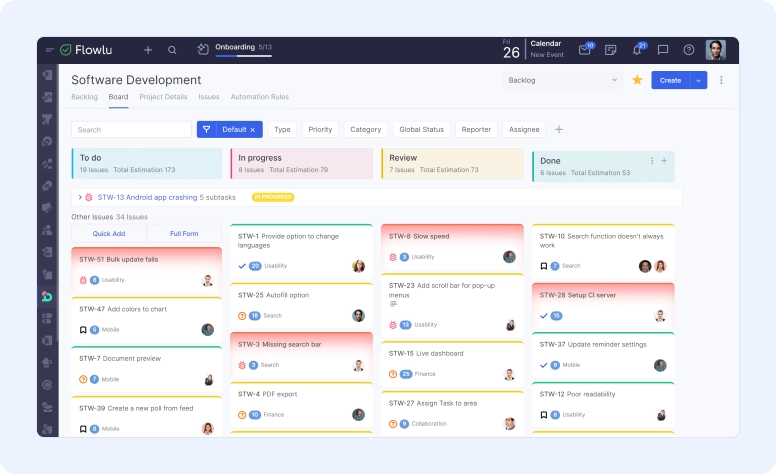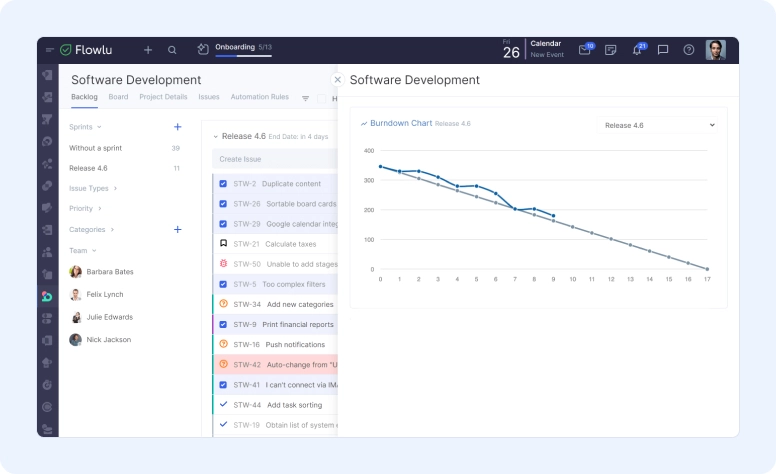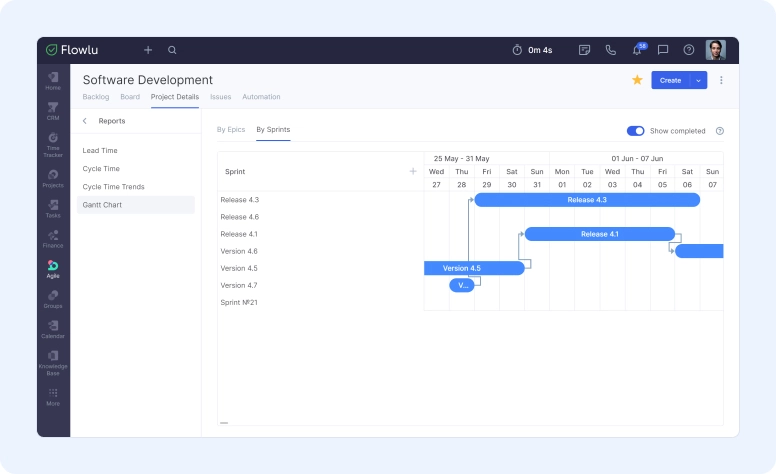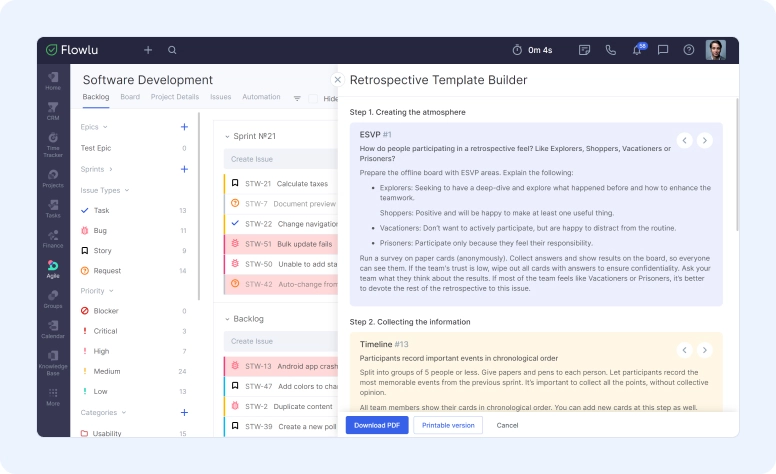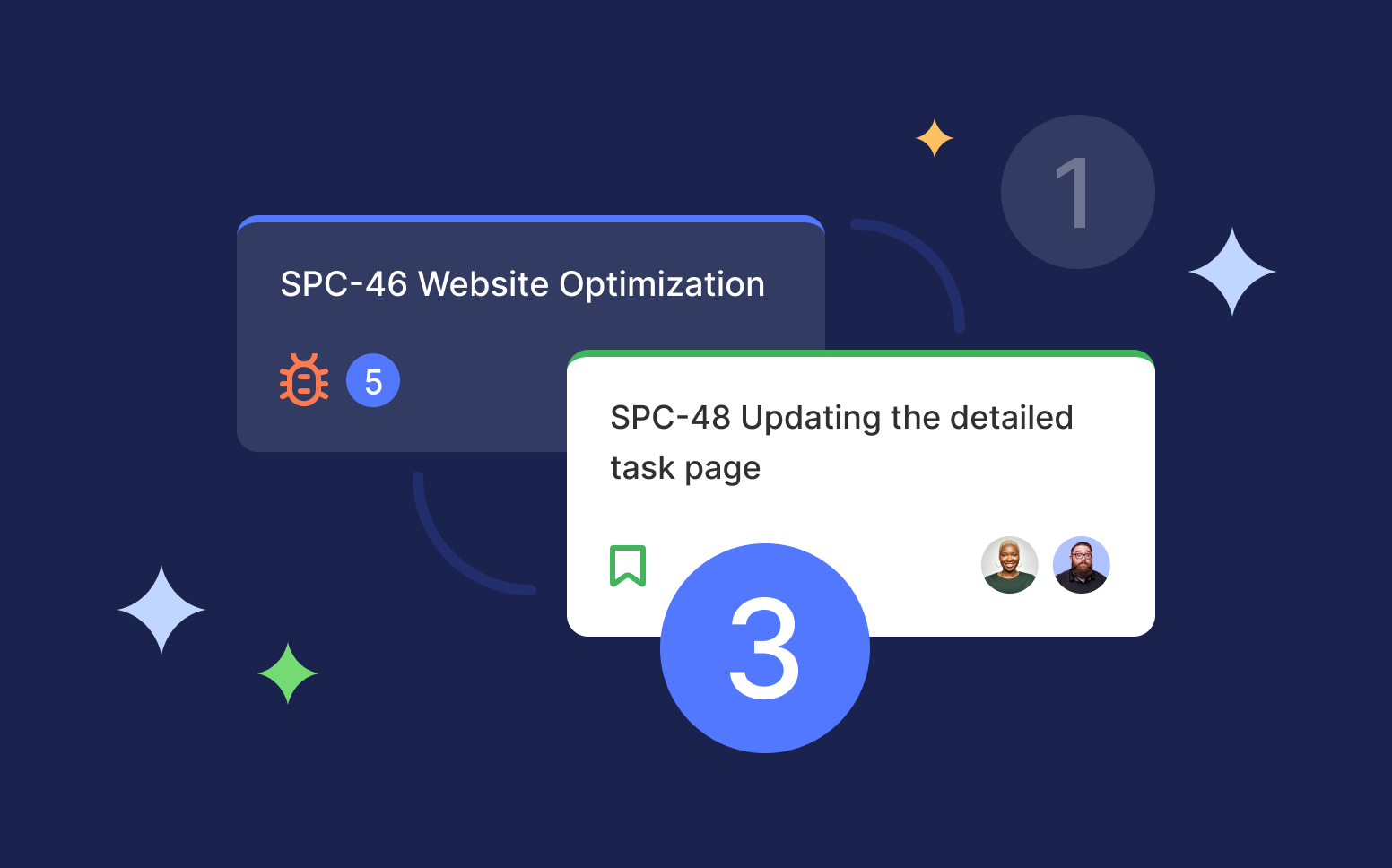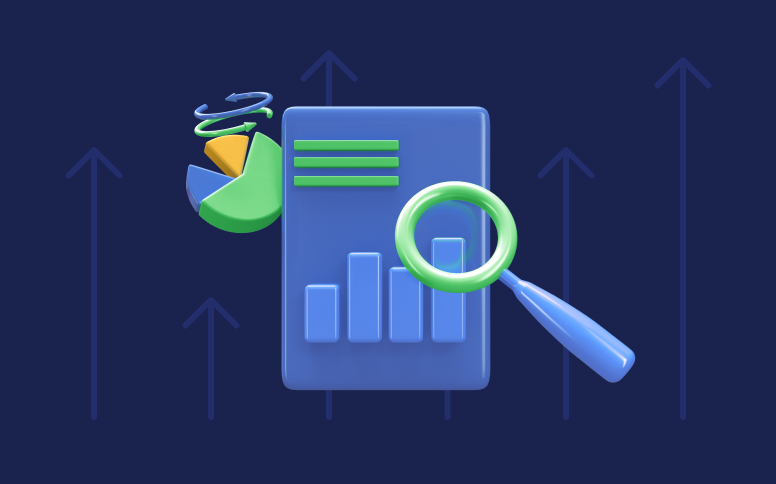Agile Planning: Step-by-Step Guide for Agile Projects and Sprints
Many companies implement Agile methodologies in their projects, seeking to increase overall productivity. Eventually, Agile-based projects are more successful than traditional ones: while the success rate of Agile projects is 42%, for traditional Waterfall projects, this rate is about 14%.
In this article, we’ll uncover the definition of Agile, the planning steps, the differences with Scrum planning, and some templates and software to use while planning your Agile projects.
Agile Project Management Definition
Agile is a flexible approach to project management. Originally applied to the development process, nowadays, Agile is widely used by many teams and industries. Without digging into Agile principles, we can define its main idea as the ability for projects to easily adapt to changes and new requirements.
The idea of change management affects Agile-based projects throughout their whole lifecycle. It means that when you plan a project, you should leave a space for changes. So, before starting a project, take some time to learn materiels and Agile planning essentials.
First of all, let’s handle some terms.
What is Planning in Agile
Agile planning is a widely-used management style. In a nutshell, it implies an iterative approach, so the project is divided into several phases, called iterations. In each iteration, there are a few sprints. Sprints are barely planned up ahead before starting a project. In most cases, Agile planning means that you’re adding changes and requests from stakeholders or owners to the work, so it’s impossible to plan what’s inside each sprint and interaction before starting working on a project.
Planning in Agile is based on feedback, requests, and user stories. Basically, we can split Agile planning into two phases: project and sprint planning. These phases require different actions and consist of different steps. We’ll analyze each phase separately in the paragraphs below.
Agile has multiple planning strategies and methodologies. One of the most popular is Scrum planning. However, even Scrum can be considered as one of Agile methodologies, Agile and Scrum planning are a bit different.
Scrum Approach in Agile Project Planning
Scrum is very similar to the Agile planning approach, but there are some concept differences between them. In simple words, Agile is a framework with core ideas and principles, while Scrm is just one of multiple methodologies to follow the Agile planning process.
In some paragraphs above, we mentioned sprints. Sprint is a common practice in Scrum. It helps to avoid in-depth planning when starting a project, so you can quickly adapt to new requirements and changes before starting a new sprint. The core planning tool in Scrum is a backlog. The backlog is the place where all requests, user stories, and other possible features are stored. Tasks in the backlog can be prioritized, divided into different categories, and literally segmented by any parameters. It helps to plan one sprint once the previous is finished. If some tasks are not completed within a sprint, they’re taken to the backlog, and they’ll be marked as the top priority in the next sprint.
In general, the Scrum approach to project planning outlines the following principles:
- Plan not an overall project, but each sprint.
- Start planning a new sprint only when the previous one is finished right away.
- Review your results after each sprint.
- Handle the retrospective meetings after a sprint or two to review the results of the whole team.
To learn how Scrum planning differs from Agile, let’s go to the main steps of the Agile planning process.
Agile Project Planning Steps
Each project has its own schedule. Traditional Waterfall projects have strict steps and deadlines, but that’s not an option for flexible Agile projects. However, Agile projects have their own scheduling, and each step requires planning. But wait, this planning is not the same as in traditional projects, mostly because you don’t need to plan everything before the project starts.
Step 1. Form clear expectations for the final delivery of a project
Before starting a project, you must have a clear understanding of the final output. In Agile-based projects, the result depends on requests from stakeholders, users (or clients), and owners. Even if their needs are changing, you can plan actions iteratively to apply changes.
Step 2. Define the details and scope of work
You can’t say exactly when you’ll finish the task unless you know its details and the factors that can influence the ETA. Understanding how much work needs to be done is one of the steps of proper Agile planning.
Step 3. Form tasks based on user stories
User stories are problems that need to be solved. In most cases, stories are complex and need to be broken down into smaller tasks. Sometimes, it’s difficult to form an exact task, and you need to complete multiple activities to solve a problem instead. Such a sequence of tasks is epic and it can last more than one sprint.
Step 4. Populate the backlog
Once user stories are split into tasks and epics, it’s time to populate the backlog. Create tasks with clear titles and descriptions, so each teammate can understand what to do. When all tasks and epics are in the backlog, set priorities, assign responsible people, and estimate the effort of each task in story points.
Step 5. Plan sprints
Typically, each sprint is equal to the iteration. Sprints also have strict timelines, for example, two or three weeks. You simply can’t put all your tasks into one sprint, that’s exactly why you need backlog planning and priorities. Tasks that have a higher priority take to the sprint first, then come older ones.
Step 6. Make up documentation
In documentation, explain the main principles and rules of a project. It helps both teams and stakeholders understand the focus of a project and request only possible changes. Documentation can change from time to time as well, but as a whole, it needs to be clear and meaningful from the beginning.
Agile Sprint Planning Steps
We figured out what Agile planning is, and now it’s time to dive into sprint planning. You might think that it's a completely different topic, but in fact, sprint planning is a part of an overall Agile planning. Here are steps that Agile teams follow to plan a new sprint:
Step 1. Schedule a retrospective meeting
Once a sprint is completed, it’s time for a retrospective. Retrospective is a regular team meeting where all teammates discuss tasks, difficulties, and issues that happened during the sprint. Such meetings help to prevent future mistakes and understand which tasks need to be taken to the upcoming sprint.
Step 2. Discuss user stories
After each sprint, you’ll probably be receiving requests and reports from users, stakeholders, and owners. As we mentioned earlier, there are user stories. Discuss all recent user stories with teammates to decide if they need to be taken to the next sprint or if maybe they’re worth working on in the latest development stages.
Step 3. Split stories and epics into smaller tasks
Sometimes it happens that you can’t cover the user story or a task during one sprint, so it becomes an epic. Split complex activities into smaller tasks and assign them to your teammates. But it’s also important to consider who was responsible for the original complex task. Maybe it is worth assigning this person as a responsible follower to this task?
Step 4. Analyze your efforts
Analytics is an important part of planning. Before planning a new sprint, analyze the time taken to complete previous tasks, their estimates in story points, and the number of teammates who participated. It will help you to wisely manage both human and time resources while planning upcoming activities.
Step 5. Tools for Agile Planning and Project Management
There are many different tools for Agile team management. Starting with a simple whiteboard and sticky notes in the 90's, Agile tools made huge progress. Now, you don’t need to physically have everything around you, and you don’t even need to work with your teammates in one office.
Here are some basic Agile planning tools to use in Flowlu:
- Backlog
As it was stated before, backlog is a place where you create tasks, set priorities, and analyze if the task is worth taking to the sprint. In Flowlu, you have a backlog for each of your projects. It prevents a project from being messy and uncategorized.
- Interactive Board
All teams and companies have different requirements, so it’s important to have the possibility to set custom stages, manage tasks’ cards and visualize the whole workflow. In Flowlu, you can manage your projects with a handy Kanban board. On the board, you can filter tasks by sprints, assignees, priorities, etc..
- Burndown Chart
The burndown chart is a widely used tool among Agile teams. This chart allows you to see how fast your team is closing tasks. In comparison to traditional charts, burndown charts show positive results if they go down because they reflect the number of tasks that need to be done.
- Gantt Chart
The Gantt chart was taken from traditional project management methodologies. However, in Flowlu, you can see it as a part of the Agile module as well. It helps to understand how much time was taken to complete each sprint or epic.
- Retrospective Template
Retrospective is a must-have for all Agile teams, but barely any managers know how to run such meetings. If you don’t have any ideas what to ask your team, Flowlu’s retrospective template builder will help you plan questions and the whole meeting.
In addition to planning tools, incorporating testing platforms such as Momentic can enhance the Agile workflow by automating end-to-end tests and providing real-time insights into application performance.
Agile Planning: Why You Need It
Planning your project according to the Agile method can help you easily adapt to changes and implement new ideas or technologies into your workflow. Why is it worth it? Simply put, it keeps all your teammates engaged and provides transparency to all processes, so you can understand the reason for difficulties and quickly handle them.
Agile project planning is an iterative approach to project management that focuses on delivering working software in short cycles.
- Flexibility: Agile projects are more flexible than traditional projects because they can be changed as needed to meet the needs of the customer.
- Speed: Agile projects can deliver working software to the customer more quickly than traditional projects because they are broken down into smaller, more manageable chunks.
- Quality: Agile projects typically produce higher-quality software than traditional projects because they involve continuous feedback from the customer.
- Customer satisfaction: Agile projects are more likely to satisfy customers because they involve close collaboration with the customer throughout the development process.
- Getting buy-in from stakeholders: It can be difficult to get buy-in from stakeholders for Agile projects because they require a different way of thinking about project management.
- Managing scope creep: It can be difficult to manage scope creep in Agile projects because the requirements are constantly evolving.
- Keeping the team focused: It can be difficult to keep the team focused on a specific set of tasks during a sprint, especially if there are distractions or interruptions.
- Measuring progress: It can be difficult to measure progress in Agile projects because the requirements are constantly changing.
- Set clear and concise goals
- Prioritize the work
- Break down the work into small tasks
- Estimate the effort required for each task
- Communicate regularly










